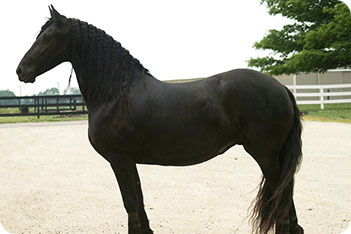
Horseback Riding - The Circle
Horse Back Flatwork
From: Equestrian and Horse | Horseback Riding
See also: Mounting | Position | Lunging | Jumping
Dismounting | Dressage Training | Rider Aids

Circle
A circle is a continuous curve where the horse maintains inside bend and energy throughout.
Sizes Of Circle
The three main sizes of circle, that are used when schooling or in competition are the 10 meter, 15 meter and 20 meter circle. When schooling they can be ridden anywhere in the school where space allows. A circle that is between 6 and 10 meters is called a Volte.
What To Look For
When a horse is on a circle it should be bending into the direction of the circle. Circles help to get the inside hind leg to push through and activate the horse from their hindquarters whilst at the same time encouraging balance, suppleness and rhythm throughout their entire body. Whilst on a circle the horse should remain tracking up, with their head level and not tilting. The horse should have a slight bend to the inside, just enough so that the rider can see the corner of the inner eyelash, as a guide if you can see the whole eye and side of the horses face you have too much bend.
Asking For A Circle
To ask a horse to circle will require several aids in varying quantities.
- The inside rein asks for a slight amount of bend, to enable the horse to be looking into the direction it is moving in.
- The outside rein controls how much inside bend you have and it also controls the speed.
- The riders inside leg should remain on the girth, from here it encourages the horse forwards as well as asking the horse to bend around it.
- The riders outside leg moves back one to two inches to be behind the girth, it is the outside leg which helps to prevent the horse from falling out too wide.
- The rider should turn through their upper body so that their shoulders follow the horses shoulders and their hips follow their horses hips. This allows the rider to be following through with the horse on the circle.
Accurate Riding Of A Circle
To ride an accurate circle takes time and practice. Good judgment of the height and width of the circle you have ridden are essential for assessing accuracy. Start off by placing cones at key points around your circle, imagine your circle as a clock face and place your cones at 12, 3, 6 and 9 o'clock respectively, this will mark out the four main quarter points of your circle, which allows you to curve around them. It is useful to start your circle off at a school marker, this will not only help to prevent drifting off course, but will also give you an exact place to start and finish.
The Ten Meter Circle
- To ride an accurate 10 meter circle from the marker E in a school that is 20 by 40 meters, you can use the centre line as your height marker as this will be exactly 10 meters in from the track.
- Place a cone just off the centre line, so that when the circle is ridden the horse will pass straight over the marker x which is on the centre line.
- Place your second cone on an inner track opposite the marker E.
- Then find the centre point between X and E and pace the distance from the centre to E, return to the centre and pace the distance out to either side of the centre placing a cone at the quarter and three quarter point.
The 15 Meter Circle
- To ride an accurate 15 meter circle, you can use the cones in the same way as with the 10 meter by placing them at quarter points.
- To judge the height from the marker E, you can use your three quarter line as it is 15 meters away from the track,( or 5 meters away from the marker B).
The 20 Meter Circle
- The best way to ride an accurate 20 meter circle is in a 20 X 40 m school. The best place to start is from start is from the marker A or C, by doing this it will give you the marker X as your height marker as the marker X is situated exactly halfway on the centre line between both A and C.
- Due to the width of the school being 20 meters wide, you should place your cones at quarter points around your circle on a slightly inner track at E and B.
- Whenever riding different sizes of circle it is important to remember that the bigger the circle the easier it is for your horse as the smaller the circle the greater the degree of collection and impulsion that will be required and therefore a greater degree of stress and strain.
- Always start off with the larger size circle first to warm your horse up. Give your horse a good selection of sizes and practice with the cones until you become proficient and then you can ride them without cones.
When To Use Circles
Once different sizes of circle have been mastered then you can ride them to balance a horse, prepare a horse for a transition or for some lateral work, help to slow down a horse who is rushing and also ride half circles to change the rein. Half circle exercises include a half 10 or 15 meter circle that returns to the track to change the rein. Two half 10, 15, and 20 meter circle that form a S shape. You can also add circles into the loops of a serpentine, to either end of a five meter loop, and to figure of eights.